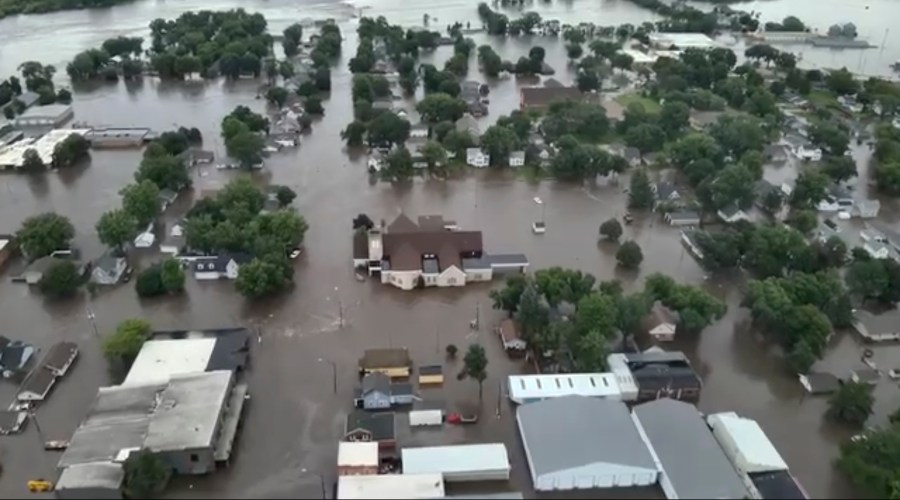SIOUX FALLS, S.D. (KELO) — Homeland Security Secretary Kristi Noem seems to have a plan to eliminate the Federal Emergency Management Agency (FEMA), an agency that has delivered hundreds of millions of dollars to the state for disaster and emergency use.
Noem shared her FEMA elimination plan during a Monday televised cabinet meeting but offered no details. Her boss, President Donald Trump, is a vocal critic of FEMA and has said he would consider eliminating it. He signed an executive order on March 19 to review FEMA’s and disaster response policies which he said were cumbersome. Both Noem and Trump have said states could be more responsible for disaster and emergency response. Noem had said in February that federal money would still be available. But again, few details about any possible FEMA cut or elimination or replacement are available.
South Dakota received more than $300 million in FEMA major disaster money from 2010 to 2015, according to Congressional Research Services. It has received millions more since 2016.
Millions came during the COVID-19 pandemic. FEMA said that as of Oct. 1, 2021, South Dakota had been approved for more than $36 million in the past 18 months. The assistance was authorized under the major disaster declaration issued for South Dakota on April 5, 2020.
The flooding in southeastern South Dakota in June of 2024 is an illustration of how FEMA money, state money and local government money combine for response to disasters and emergencies in the state.
On Oct. 16, the Biden Administration said federal agencies approved more than $14.7 million in grants and loans to assist in recovery for the summer flooding disaster. FEMA had approved $8.6 million through the Individuals and Households program, consisting of $5.8 million in Housing Assistance for home repairs and rental expenses, and $2.8 million in Other Needs Assistance for repair or replacement of personal property, vehicle repair or replacement, moving expenses and other disaster-related needs.
Sewer mains under the Vermillion River broke during the flooding in the city of Vermillion.
The city spent about $995,000 to repair the system, the city’s finance director Katie Redden said.
Seventy-five percent of the cost, or about $746,000, came from FEMA money, Redden said.
The state chipped in about $150,000 for 15% of the cost while the city provided 10% of the cost, Redden said.
The city would not have been able to complete the project without FEMA money, Redden said.
The city of Canton also provided 10% toward a “quick repair” of a sewer line damaged in the June flooding, said city manager Andrew Pietrus.
The state contributed 15% and FEMA contributed 75%, he said.
The 75% FEMA split is standard for infrastructure projects, South Dakota Department of Public Safety Deputy Secretary Kristi Turman said in a joint appropriations committee meeting on Jan. 24.
South Dakota has a special emergency and disaster special revenue fund that typically needs to be refilled at each legislative session. The DPS was in appropriations on Jan. 24 seeking about $4.9 million to cover expenses, many of which were related to the June 2024 flooding.
As of Jan. 24, there was about $3.5 million in expenses related to the June flooding, DPS Administration Director Angie Lemieux said.
“We’re taking the agreed on 15%,” Lemieux said. “That was what we agreed to pay.”
Canton is now waiting for possible FEMA money for the design of flood mitigation project, Pietrus said. The award of the money isn’t scheduled to happen until 2027, although officials said Wednesday the state already has the money, Pietrus said.
“We’ve decided to forgo some FEMA money…,” Pietrus said of funding money for design and analysis.
“That’s two more rounds of spring flooding,” Pietrus said of the main reason the city will move ahead with design and analysis.
The city could still get reimbursed by FEMA for the design. The city can also apply for project construction, he said.
“Depending on the cost of the project, is it work waiting for a year and half for FEMA dollars,” Pietrus said of another decision for the city.
Both Redden and Pietrus said using FEMA dollars requires a lot of paperwork. But, Pietrus said the process isn’t cumbersome.
“It’s not horrible,” Pietrus said. “The only tough part is just the delay (in finding out about approval).”
The state money is key with funding projects and it can get reimbursed for some disaster and emergency costs.
On Feb. 23, 2024, the Joint Appropriations Committee said payments from other states for South Dakota help or Federal Emergency Management Agency (FEMA) money is often used to backfill the fund.
Then lawmaker Republican Rep. Bryan Breitling said about $2.7 million in the emergency and disaster bill had gone through insurance, other state payments and other sources. On Feb. 24, 2024, the state was seeking another $1.5 million is additional money was for National Guard troop deployment to Texas at the border with Mexico.
In most legislative years, the appropriated money is a backfill for the state fund which leads to how would the state provide enough money for disaster and emergency relief without federal money.
Republican Rep. Chris Kassin attempted to get up to $2 million from the legislature this session to help with any gap in the clean-up of McCook Lake. The lake had been damaged during the June flooding. While the state Game Fish and Parks plan to clean debris from the lake, Kassin said he was worried the clean-up would not be sufficient and more money would be needed. Lawmakers rejected the request.
Then Gov. Noem allocated $9,918,359 in her 2019 budget to a new loan program for disaster funding for long-term recovery. The program would allow cities, counties, townships and tribes to apply for these loans.
The year of 2019 was the same year South Dakota had received at least four federal disaster declarations.
When the Trump Administration declared a disaster in November of 2019, it was for three tornadoes that struck Sioux Falls and the extreme flooding in communities such as Madison and Mitchell in September. Noem had requested a preliminary $17 million in federal assistance.
As of October of 2024, the Biden Administration said a total of 1,407 people in Davison, Lincoln, Turner, and Union counties had applied with FEMA for assistance related to the June flooding. FEMA had approved $8.6 million through the Individuals and Households program, consisting of $5.8 million in Housing Assistance for home repairs and rental expenses, and $2.8 million in Other Needs Assistance for repair or replacement of personal property, vehicle repair or replacement, moving expenses and other disaster-related needs.
Although some winter storms have brought damage, South Dakota’s vulnerability is flooding. The associated costs can add into the millions.
The State of South Dakota Hazard Mitigation Plan April 2019 cited the National Centers for Environmental Information storm events database to show the number of floods that happened in the state between 1993 and August 2015. The database recorded 1,302 floods with total property and crop damage estimated at $310.6 million in 2016 dollars.
March through May flooding in 1995 caused preliminary damage estimates of “$9.3 million in damage to infrastructure of public facilities. Roads, Bridges and Utilities incurred the most damage with almost $5.7 million and $2.6 million in estimated damages, respectively. Federal aid system roads received $7.1 million in damage,” according to the hazard mitigation plan.
In 2010, about $113 million in federal disaster money came to South Dakota. This was the year of the record flooding on the James, Vermillion and Big Sioux Rivers in eastern South Dakota.


